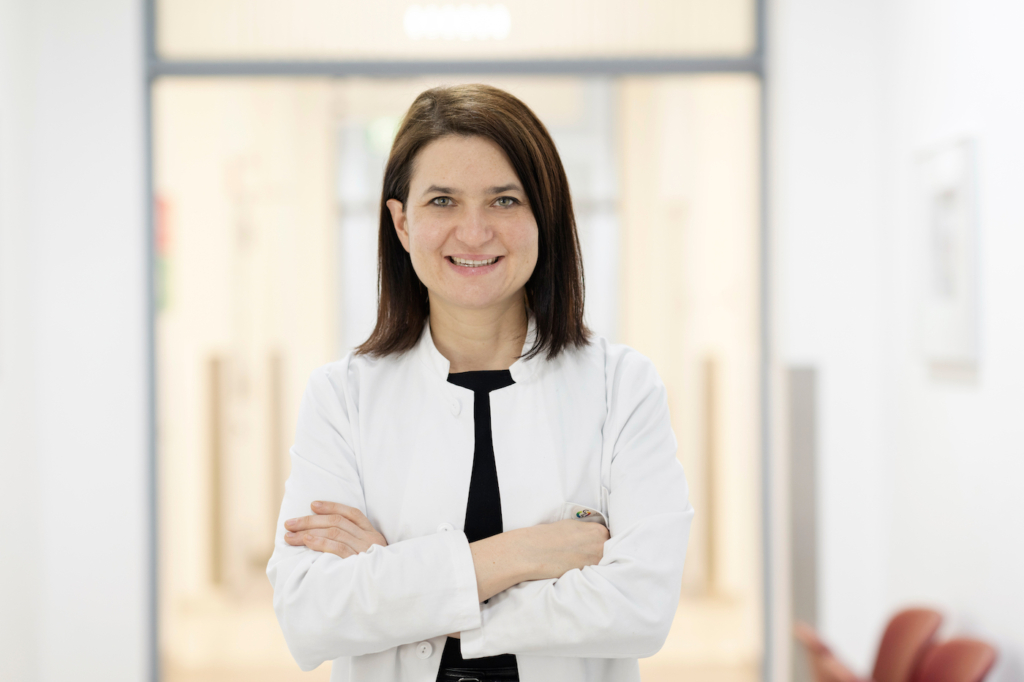Every Head is Different
Throbbing, wrenching, stabbing: headaches can differ a lot – and almost everyone has them. The West German Headache Center in Essen is researching the problem, and developing new insights.
By Katrin Koster
Last week a lecture at a conference in Vienna, then her consulting hours, and after that promoting a new online course via Instagram: Prof. Dr Dagny Holle-Lee is very active. She is one of Germany’s leading migraine researchers and since 2014 has headed the West German Headache Center in Essen, the largest in Germany, where they treat roughly 4,000 patients a year. ‘Some just need one consultation, others we support for years, because the complaints are very individual’, says Holle-Lee.
Trying to explain migraines is like a giant puzzle, because the triggers, pattern and symptoms can differ so much. Some aspects are now understood, but we still lack understanding of how things interconnect: what is the trigger and what is the consequence of an attack.
All of this makes diagnosis difficult: ‘There are no biomarkers like we have with a heart attack. From both a medical perspective and that of their sufferers, the causes of headaches are often only diagnosed late. Many think they are just a normal part of life and you have to put up with it. We want to change this’, says the 42-year-old, who also works as senior physician in the neurological department.
There are more than 200 types of headache – the two most common are the dull, oppressive tension headache and the throbbing-pulsing migraine. The latter is the most common neurological disease – and the most harmful to quality of life. Current studies by the Robert Koch Institute indicate that over 28 percent of all women and over 18 percent of all men in Germany are affected. Mostly they start in puberty, but for some it is even in childhood. Often the migraines become increasingly frequent over the course of a lifetime, and only start to recede gradually in old age.
In the chronic form, the pains occur on 15 or more days a month, sometimes accompanied by dizziness, nausea or visual disturbances. Yet anyone who takes pain medications or migraine remedies too often risks their pains becoming chronic – a cycle that has to be broken.
»When the pain therapy starts, their life changes massively for the better.«

THREE QUESTIONS
The Headache Center carries out more comprehensive diagnosis than GPs do, because it can draw on various disciplines. Three questions help to categorise the symptoms neurologically and identify the right treatment:
How long does the headache last?
What other symptoms are there at the same time?
Does the sufferer feel the need for quiet, or are they restless?
‘Every day in my consulting hours I can see how much headaches can spoil everyday life. And how much we can change things. When the pain therapy starts, their life changes massively for the better, and that’s our greatest motivation’, explains Holle-Lee, who always combines medicinal treatments with non-pharmaceutical ones.
WHAT CAN HELP WITH MIGRAINES AND HEADACHES?
The answer is classic: drink enough each day, and above all exercise or endurcance sports, relaxation and pressure in moderation, and the right amount of sleep – not too much and not too little.
Clinical research at the Headache Center embraces several aspects: ‘Using our massive databases, amongst other things, we’re studying which patients benefit from which therapies.’ Both in clinical work and in clinical research there is a close cooperation with Prof. Dr Ulrike Bingel of the University Pain Center. Here, the focus is on the influence of patients’ expectations of headache treatments and whether placebo therapy can work.
‘Without intensive national and international networking, research can’t function,’ Holle-Lee emphasises. The clinically-controlled study into the use of a mobile software application to prevent overuse of medicines and associated headaches, the centre’s largest project, involves 30 headache centres and specialist neurological practices across Germany. The study is set to run for three years with 2.4 million euros funding from the German Research Foundation (DFG). Study participants use the app to record how often they take painkillers. The app warns them if they are taking too much, because this can also contribute to an episodic problem becoming chronic. Almost 120 patients are currently involved, more are being sought.
NUMEROUS EXPERIMENTAL APPROACHES
They are also researching whether migraine brains function differently: one experiment, for example, is studying whether sufferers respond more strongly to dizziness triggers such as rotating on a swivel chair. A typical feature is that migraine patients get sick far faster and recover more slowly than healthy people.
Another experiment is looking at how the brain processes images, because headache sufferers perceive light and rapid image changes more strongly. This uses electrophysiological diagnosis to examine whether this oversensitivity of the brain can be gauged objectively – in other words measuring how sensitive someone is. They are also studying the blood of patients, as it is possible that there are changes in the immune cells. This is currently being studied in a research project at the Clinician Scientist Academy of University Medical Centre Essen (UMEA).
‘Sadly, until now there haven’t been any biomarkers to show that someone is suffering from a migraine,’ says Holle-Lee of these scientific approaches. ‘So they’re often not regarded as proper organic disorders, but they definitely are.’
The research questions are as varied as the factors that could influence migraines, e.g. living conditions, alcohol consumption, and hormones. Although there are now a few unifying criteria, they appear different in everyone. A headache diary can help to identify connections.
In conclusion, the specialist, who herself sometimes has headaches, emphasises, ‘it is really important to me to stress that sufferers are not culpable for their migraines. In the end, the main factors are hereditary links. People are born with a migraine brain, and we don’t yet understand why and how the condition develops in one and not another.’
THE ESSEN HEADACHE CENTER
is part of the University Pain Center and is networked with registered neurologists and pain therapists and other headache centres in Germany. It brings together specialists from neurology, general practice, and anaesthesia. The focus at the Medical Faculty is on neurosciences.
Main image: © Julius Maxim



